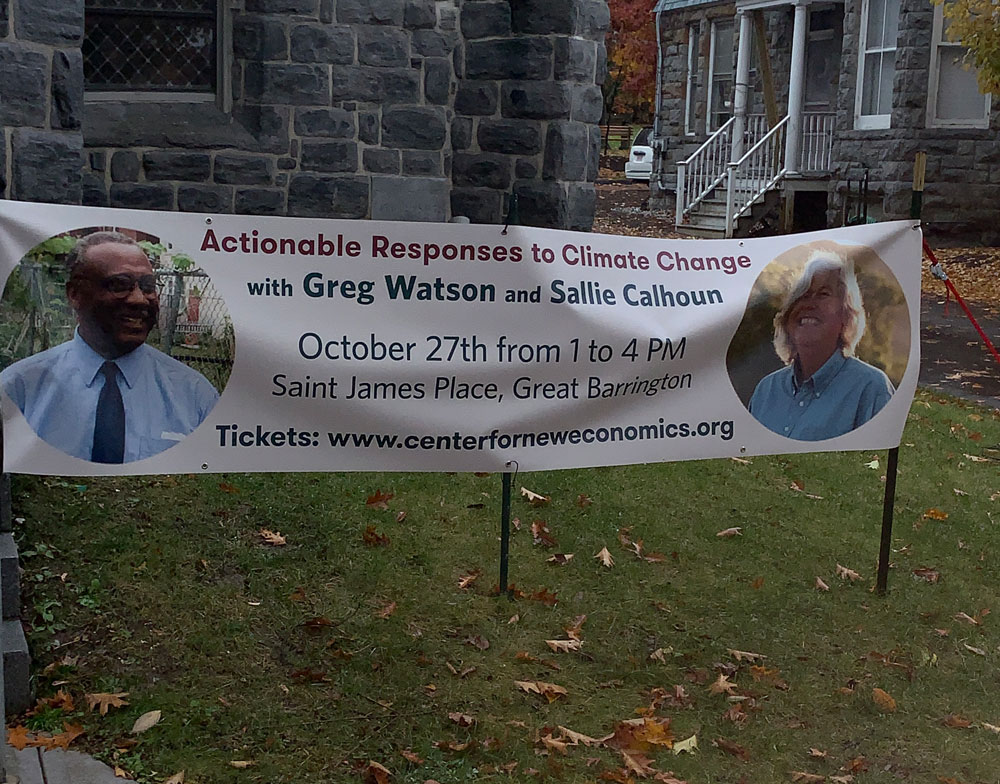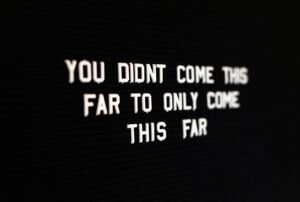

This past October, hundreds gathered in the small town of Great Barrington, Massachusetts, for the 39th annual E.F. Schumacher lectures., an event organized by the nonprofit Schumacher Center for New Economics. Over the years, a number of high-profile speakers have headlined the annual event, including Wendell Berry, Jane Jacobs, Van Jones, and Winona LaDuke, to name just a few.
This year’s theme—actionable responses to climate change—was nothing if not timely. Speaking on this topic were Sallie Calhoun—co-owner with her husband Matt Christiano of Paicines Ranch, a 7,600-acre (11.875 square miles) farm near Monterrey, California, and founder of an impact investing fund, Cienaga Capital—and Greg Watson, former Massachusetts Commissioner of Agriculture and a student of Buckminster Fuller, whose work centered on holistic approaches.
A central theme that emerged from both speakers was the need to take action, even as the path to ultimately achieving climate stabilization remains uncertain. As both speakers made clear, there are plenty of approaches that can be taken to address the global climate emergency. At the same time, given the complexity of human social systems, there are no easy, ready-made solutions that will guarantee success. Creativity and flexibility, in short, will be required.
As Watson cautions, the goal cannot be to avoid climate change, because already “we are in the midst of climate change.” Instead, Watson contends, the goal is “to avoid the worst-case scenario.” How does one do that? Calhoun and Watson addressed this question from two directions. For her part, Calhoun addresses the question from what a single practitioner (albeit one with considerable philanthropic resources) can do. Calhoun does not attempt to develop a systemic approach, but instead talks about the approach she has taken as a philanthropist and investor. By contrast, Watson attempts to address the question of climate change at the level of the global system.
Addressing Climate Change amidst Uncertainty
Calhoun was born in the 1950s in Knoxville, Tennessee. She went to Rice University to study engineering and moved to Silicon Valley, where she was one of a small number of women engineers, and made her fortune as chief operating officer of Globetrotter Software, a company she co-owned with her husband. Selling the company in 2000 gave Calhoun and her husband the cash that enabled them to purchase the 7,600-acre Paicines Ranch a year later, where they have sought to implement principles of regenerative agriculture.
In 2014, Calhoun became a cofounder of an investment company called Cienaga Capital, which makes loans and grants in regenerative agriculture. As Calhoun describes her work, her goal “is to regenerate soils in America.” Calhoun adds that she calls the whole initiative the “No Regrets” initiative, since she wants to be able to look back at her own actions with regard to climate change without regret. In general, the initiative invests in carbon sequestration and negative emissions technologies that promise to “take carbon dioxide out of the atmosphere.”
Calhoun emphasizes the need to act now. Calhoun noted that she and her husband decided that a perpetual foundation did not make sense given the severity of the climate emergency. “How can anyone talk about perpetuity?” Calhoun asks. “We need to have a world that future charitable funds can operate in.”
“We picked 10 years,” Calhoun adds. “In 10 years, I’ll turn 70.” Her hope is that within 10 years, soil health, rather than “being a little room to the side” in climate crisis discussions, “will be in the center.”
Calhoun concedes that increasing soil absorption of atmospheric carbon is just one tool of many to address the climate emergency. Still, she contends, it is an important one. As NPQ’s Marian Conway noted earlier this year, a single application of natural compost on half of California’s rangeland could “increase the capacity for carbon sequestration by 42 million metric tons,” a nontrivial contribution of about 0.7 percent of total annual US emissions.
Soils, if properly maintained, can remove a considerable amount of carbon out of the atmosphere. “In a lot of cases, we know what to do, but we don’t know how to pay for it,” Calhoun explains. Changing the crop insurance system to promote restorative soil practices by farmers would be one lever that could greatly accelerate progress.
As Calhoun points out, restorative soil practices, even though they are officially promoted by the US Department of Agriculture, are hardly the norm. Most vineyards, for example, “are tilled to death.” This kills native grasses that can help absorb carbon. On Paicines Ranch, Calhoun’s family is having some success at getting native grasses to come back, though a lot of the work involves “trying to come up with systems that are financially viable and build soil health.”
The fund Calhoun supports has invested $47 million to date, with $23 million currently outstanding in 58 loans. Calhoun adds, “On the philanthropic side, we do operating grants and a few loan guarantees.” All told, Calhoun estimates that there have been 80 grants. which total about $2 million.
The goal, as Calhoun explains it, is to focus on making a lot of “small bets,” with the hope that by doing so an ecosystem of small organizations develops. This stands in contrast to the current philanthropic fashion of making “big bets.”
“It is all about seeing differently and connecting people into a vibrant network of people trying to change the world. Every bit of our work informs every other bit,” Calhoun explains. Or, as Calhoun puts it, the vision is about “scaling across rather than scaling up.”
Part of the reason for these small bets is the opacity of future development. Calhoun quips, “As my son says, ‘I can predict the future. I’m just usually wrong.’”
Sign up for our free newsletters
Subscribe to NPQ's newsletters to have our top stories delivered directly to your inbox.
By signing up, you agree to our privacy policy and terms of use, and to receive messages from NPQ and our partners.
Still, there is more intentionality behind Calhoun’s approach than simply making a bunch of small bets and hoping some pay off. Fostering communication within emerging networks is one critical strategy for helping connect the disparate efforts. Calhoun notes that she and her husband are founding members of a number of collaboratives for this reason.
Calhoun emphasizes that responding to climate emergency requires a willingness to act with a high degree of uncertainty. “How does this scale in the time that we have?” Calhoun asks. The challenge, Calhoun notes, is not small: “Last fall, we were asking the question of, ‘Can we live in the face of smoke and destruction?’ This year, we have intermittent electricity for three months. It is grim.”
Calhoun concedes, “Any plan that I can give you that was hopeful and might effect change is totally unrealistic.” What is the way out? For Calhoun, the only reasonable path is to hope that many different efforts, approaching the question of climate change mitigation from different directions, might in combination succeed at capping runaway global heating.
Calhoun adds, “I think it will look like magic.” Still, she contends that, by supporting a wide range of community-based climate change mitigation strategies, “the conditions for magic” can be created.

Climate Change Viewed from a Systemic Perspective
As noted above, if Calhoun approaches the question of climate change mitigation from the perspective of a single philanthropist, Watson attempts to apply whole-systems thinking to the challenge of the global climate emergency. Yet, even so, Watson agrees with Calhoun that, “what we need is a diversity of perspectives.”
Watson highlights a few areas where he feels coordinated effort at the global level might help boost the kind of local efforts Calhoun champions. One of these vectors is policy.
“Policy is a powerful tool if it is used correctly and it is an inclusive policy,” Watson explains. “Humanity has a once-in-century chance: to fix an economic system that is failing on multiple fronts.”
In particular, Watson lifts up attention to proposals for a Green New Deal, noting that the matter of a “green new deal” is not simply a matter of policy, but of creating “a new worldview.”
Watson says he is optimistic that in that some fields, such as sustainable agriculture, society has a “head start” on new worldviews that he views as necessary for addressing the global climate emergency. Watson contends that applying biomimicry—that is, the conscious design of technology in such a way that it works with and boosts natural systems, instead of trying to “overcome” nature—is one promising strategy. The restorative soils approach Calhoun is working on, of course, is one example of a strategy that seeks to accentuate natural processes that can remove carbon from the atmosphere.
Watson, drawing on the work of his late mentor Fuller, also advocates using simulations as a tool to spur both new thinking and technological development. Watson observes that “war games” are frequently used by military planners. Instead, Watson suggests, we could apply what he calls “world games” that use the “same information, the same data, and…instead of developing weapons, put that to the use of solving human needs for everyone on Spaceship Earth.”
A lot of our technology, Watson points out, comes from military research—supercomputers, software, fiber optics, artificial intelligence, satellite technology, broadband internet, and transistors. Watson suggests that with a concentrated focus on the climate emergency, the focus could shift from designing technology for weaponry to designing technology for sustaining life.
Watson also warns against magical thinking that might imply that green technology—unlike all forms of technology that have preceded it—will have solely beneficial consequences. A “reality we have to face,” Watson says, “is that some renewable energy technologies themselves depend on extractive industry.” Watson emphasizes, “We have to be honest about that. You still have to go into the mines to get rare earth minerals.” The challenge is that even if a new model based on renewable energy succeeds in making the old fossil fuel industries obsolete, the result is highly unlikely to be a utopia. Success, Watson observes, “creates new problems.”
Closing Thoughts
Not surprisingly given the global dimensions of the climate challenge, thinking about the climate emergency has often focused on big centralized initiatives. Certainly, both Watson and Calhoun strongly favor policy frameworks like the Green New Deal that can amass resources on the scale required to meet the challenges we face. At the same time, both Calhoun and Watson emphasize the importance of experimentation and local action.
It is a point that has been made before. The late Elinor Ostrom, who won the Nobel Prize in Economics in 2009, argued in a background paper produced for the 2010 World Development Report on Climate Change that a “polycentric approach,” rather than a centralized, global approach is to be preferred. One reason, she offered, is that “waiting for effective policies to be established at the global level is unreasonable.”
But, Ostrom added, there is a positive reason too—namely, to “encourage experimentation and learning from diverse policies adopted at multiple scales.” Ostrom, who won her Nobel Prize based on her studies of the conditions for effective collective action, drawing on over 5,000 case study examples, also observed that it is far easier to build the trust and commitment necessary to achieve behavioral change if larger scale problems are broken down and made meaningful at the local level.
In short, if we take the observations of Calhoun, Watson, and Ostrom to heart, the real work of addressing the climate emergency will occur not just in the halls of government, but in the actions of our own local communities. It is a message that emphasizes the very real role—and responsibility—that organizations in civil society will have to play.













